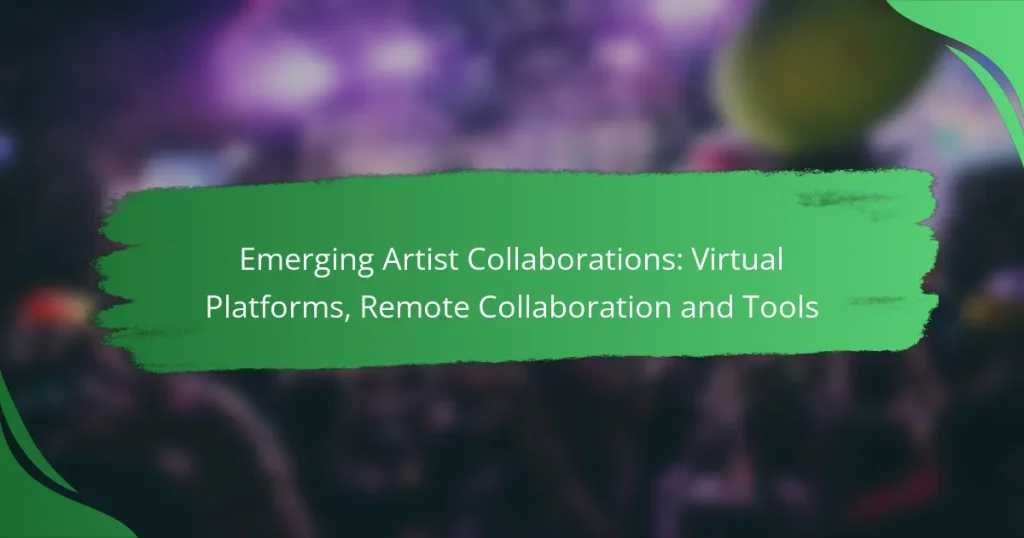Emerging artists are increasingly turning to virtual platforms to collaborate, utilizing a range of online tools that enhance communication and project management. These digital solutions enable seamless teamwork, allowing artists to connect and create together from anywhere in the world. By embracing remote collaboration, artists can access diverse talent and reduce costs, breaking down geographic barriers in the creative process.
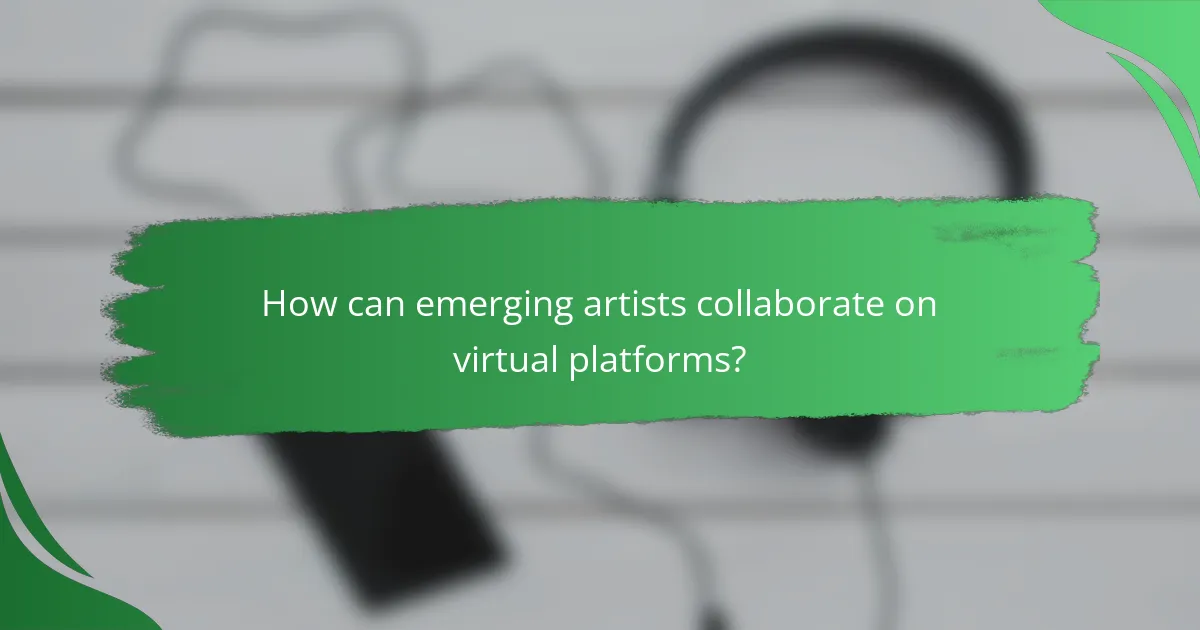
How can emerging artists collaborate on virtual platforms?
Emerging artists can collaborate on virtual platforms by utilizing various online tools designed for remote teamwork. These platforms facilitate communication, creative sharing, and project management, making it easier for artists to work together regardless of their physical locations.
Using platforms like Soundtrap
Soundtrap is an online music studio that allows artists to create, collaborate, and share their work in real-time. Users can record vocals, add instruments, and edit tracks directly in their web browser, making it accessible from anywhere. It’s particularly useful for musicians looking to co-write songs or produce tracks together without needing to meet in person.
To maximize collaboration on Soundtrap, artists should familiarize themselves with its features, such as the ability to leave comments on specific sections of a track. This feedback mechanism can enhance the creative process and ensure everyone’s ideas are considered.
Leveraging collaboration features in BandLab
BandLab offers a comprehensive suite of tools for music creation and collaboration, including a digital audio workstation (DAW) and social networking features. Artists can invite others to join their projects, allowing for seamless contributions and edits. The platform supports various genres and styles, making it versatile for different artistic expressions.
When using BandLab, artists should take advantage of its built-in community features to share their work and receive feedback. Engaging with other users can lead to new collaborations and opportunities for growth.
Utilizing Zoom for live jam sessions
Zoom is an effective platform for hosting live jam sessions, enabling artists to connect in real-time via video conferencing. This setup allows musicians to play together, share ideas, and refine their performances as if they were in the same room. It’s particularly beneficial for rehearsals or brainstorming sessions.
To ensure a smooth experience on Zoom, artists should check their internet connection and audio settings beforehand. Using high-quality microphones and headphones can significantly improve sound quality, making the collaboration more enjoyable and productive.
Employing Discord for community engagement
Discord serves as a powerful tool for community engagement among emerging artists. By creating dedicated servers, artists can build a space for discussions, share resources, and collaborate on projects. The platform supports text, voice, and video communication, catering to various preferences for interaction.
Artists should consider setting up channels for specific topics, such as songwriting, production tips, or feedback sessions. This organization helps keep conversations focused and encourages active participation from community members, fostering a supportive environment for collaboration.
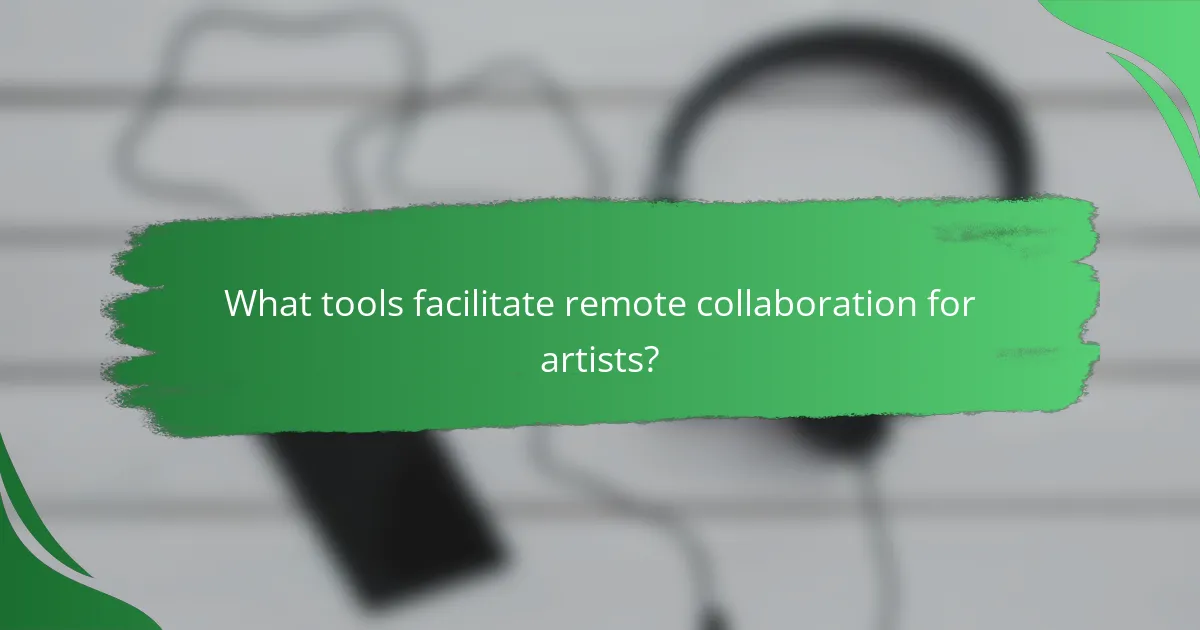
What tools facilitate remote collaboration for artists?
Remote collaboration for artists is facilitated by various digital tools that enhance communication, creativity, and project management. These platforms allow artists to work together seamlessly, regardless of their physical locations.
Using Procreate for digital art collaboration
Procreate is a powerful digital painting app that supports collaboration through features like shared canvases and export options. Artists can work on the same artwork in real-time or share their files for feedback and revisions.
To collaborate effectively, ensure that all participants have compatible versions of Procreate. Utilize the app’s export features to share high-resolution files, and consider using layers to keep individual contributions organized.
Employing Google Drive for file sharing
Google Drive is an excellent tool for artists to share files, including images, documents, and videos. It allows for easy access and collaboration, enabling multiple users to view and edit files simultaneously.
When using Google Drive, organize your files into folders for different projects or collaborations. Set appropriate sharing permissions to control who can edit or view your work, and regularly back up your files to avoid data loss.
Utilizing Trello for project management
Trello is a visual project management tool that helps artists keep track of tasks and deadlines. It uses boards, lists, and cards to organize projects, making it easy to assign roles and monitor progress.
To maximize Trello’s effectiveness, create a board for each collaboration and break down tasks into manageable cards. Use labels to categorize tasks by priority or status, and set due dates to keep the project on track. Regularly review the board with your team to ensure everyone is aligned on goals and timelines.
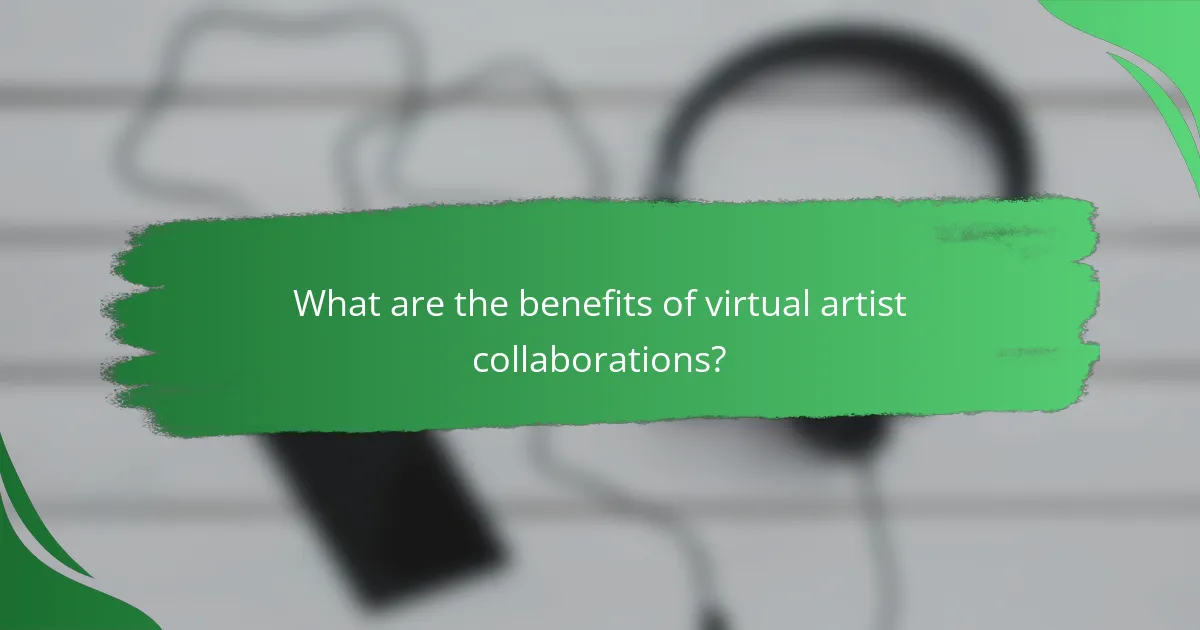
What are the benefits of virtual artist collaborations?
Virtual artist collaborations offer numerous advantages, including increased accessibility to diverse talent and reduced costs. By leveraging technology, artists can connect and create together regardless of geographic barriers.
Access to a global network of artists
Virtual platforms enable artists to collaborate with peers from around the world, expanding their creative horizons. This access to a global network fosters diverse perspectives and innovative ideas, enriching the collaborative process.
For example, an artist in Berlin can easily partner with a musician in Tokyo, blending different cultural influences into their work. This cross-pollination can lead to unique artistic expressions that might not be possible in a localized setting.
Cost-effective collaboration options
Collaborating virtually often reduces expenses associated with travel, accommodation, and studio rentals. Many online tools and platforms offer free or low-cost options, making it easier for artists to work together without significant financial investment.
For instance, using software like Zoom or Google Meet allows artists to hold meetings and share ideas without the need for physical presence. This cost-effectiveness is particularly beneficial for emerging artists who may have limited budgets.
Flexibility in scheduling and location
Virtual collaborations provide flexibility in terms of when and where artists can work together. This adaptability allows participants to schedule sessions that fit their individual routines, accommodating different time zones and personal commitments.
Artists can choose to collaborate from their home studios or any location with internet access, which can lead to increased productivity. However, it’s essential to establish clear communication and deadlines to ensure that all collaborators remain aligned throughout the project.
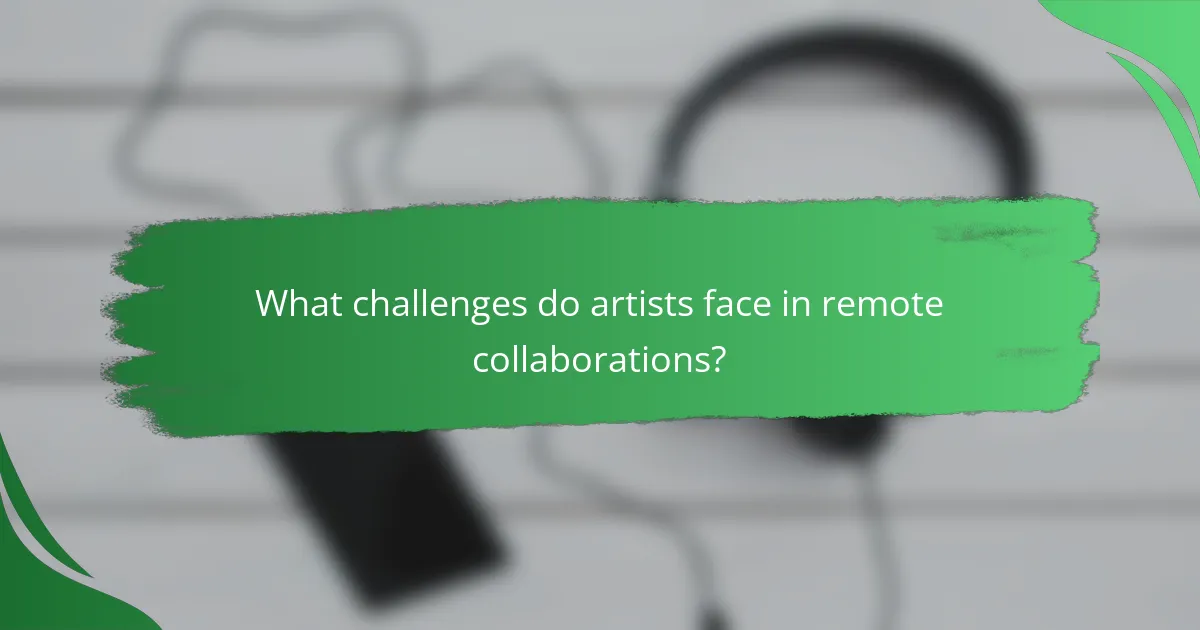
What challenges do artists face in remote collaborations?
Artists engaging in remote collaborations often encounter several challenges that can hinder their creative processes. Key issues include time zone differences, technical problems with collaboration software, and a lack of personal interaction, all of which can affect communication and project outcomes.
Time zone differences
Time zone differences can create significant barriers in remote collaborations, making it difficult for artists to coordinate schedules. For example, if one artist is based in New York and another in Tokyo, a 14-hour gap can limit overlapping working hours, leading to delays in feedback and decision-making.
To mitigate these challenges, artists can establish a shared schedule that accommodates all parties, using tools like World Time Buddy or Google Calendar. Setting regular check-in times can help ensure that everyone stays aligned despite the geographical distance.
Technical issues with software
Technical issues with collaboration software can disrupt the creative flow and lead to frustration. Common problems include software compatibility, connectivity issues, and inadequate training on tools like Zoom, Slack, or collaborative design platforms.
Artists should prioritize using reliable and user-friendly software, and consider conducting a trial run before starting a project. Providing tutorials or resources for team members unfamiliar with the tools can also enhance efficiency and reduce technical hiccups.
Lack of personal interaction
A lack of personal interaction in remote collaborations can lead to misunderstandings and a diminished sense of team cohesion. Without face-to-face communication, artists may struggle to build rapport, which is often crucial for creative synergy.
To foster connection, artists can incorporate video calls into their routine, use virtual brainstorming sessions, or even schedule informal catch-ups. Engaging in team-building activities, even online, can help strengthen relationships and improve collaboration outcomes.

How to choose the right platform for collaboration?
Selecting the right platform for collaboration involves considering user experience, integration capabilities, and specific project needs. A well-suited platform enhances communication and streamlines workflows, making it easier for artists to collaborate effectively, regardless of their location.
Assessing user interface and ease of use
The user interface (UI) of a collaboration platform significantly impacts how artists interact with it. A clean, intuitive UI allows users to navigate easily, reducing the learning curve and enabling quick adoption. Look for platforms that offer customizable dashboards and simple navigation to enhance user experience.
Consider conducting a trial run with a few team members to gauge their comfort level with the interface. Platforms that provide tutorials or customer support can also ease the transition, making it simpler for artists to focus on their creative work rather than technical challenges.
Evaluating integration with existing tools
Integration capabilities are crucial when choosing a collaboration platform, as they determine how well the new tool will fit into your current workflow. Check if the platform can seamlessly connect with tools you already use, such as project management software, cloud storage, or design applications. This can save time and reduce the need for duplicate data entry.
Prioritize platforms that support popular integrations and offer APIs for custom solutions. A good practice is to create a list of essential tools and verify that the collaboration platform can work with them effectively, ensuring a streamlined workflow for all team members.
